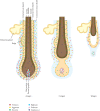Integral Roles of Specific Proteoglycans in Hair Growth and Hair Loss: Mechanisms behind the Bioactivity of Proteoglycan Replacement Therapy with Nourkrin® with Marilex® in Pattern Hair Loss and Telogen Effluvium
- PMID: 32425997
- PMCID: PMC7222612
- DOI: 10.1155/2020/8125081
Integral Roles of Specific Proteoglycans in Hair Growth and Hair Loss: Mechanisms behind the Bioactivity of Proteoglycan Replacement Therapy with Nourkrin® with Marilex® in Pattern Hair Loss and Telogen Effluvium
Abstract
Follicular proteoglycans are key players with structural, functional, and regulatory roles in the growth and cycling behaviour of the hair follicles. The expression pattern of specific proteoglycans is strongly correlated with follicular phase transitions, which further affirms their functional involvement. Research shows that bioactive proteoglycans, e.g., versican and decorin, can actively trigger follicular phase shift by their anagen-inducing, anagen-maintaining, and immunoregulatory properties. This emerging insight has led to the recognition of "dysregulated proteoglycan metabolism" as a plausible causal or mediating pathology in hair growth disorders in both men and women. In support of this, declined expression of proteoglycans has been reported in cases of anagen shortening and follicular miniaturisation. To facilitate scientific communication, we propose designating this pathology "follicular hypoglycania (FHG)," which results from an impaired ability of follicular cells to replenish and maintain a minimum relative concentration of key proteoglycans during anagen. Lasting FHG may advance to structural decay, called proteoglycan follicular atrophy (PFA). This process is suggested to be an integral pathogenetic factor in pattern hair loss (PHL) and telogen effluvium (TE). To address FHG and PFA, a proteoglycan replacement therapy (PRT) program using oral administration of a marine-derived extract (Nourkrin® with Marilex®, produced by Pharma Medico Aps, Aarhus, Denmark) containing specific proteoglycans has been developed. In clinical studies, this treatment significantly reduced hair fall, promoted hair growth, and improved quality of life in patients with male- and female-pattern hair loss. Accordingly, PRT (using Nourkrin® with Marilex®) can be recommended as an add-on treatment or monotherapy in patients with PHL and TE.
Copyright © 2020 Jan Wadstein et al.
Conflict of interest statement
The authors report no conflicts of interest that may affect the integrity of this work.
Figures


References
Publication types
LinkOut - more resources
Full Text Sources
Miscellaneous

